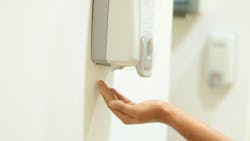Patient infection risk cut with hygiene-monitoring program
For hundreds of years, it’s been customary for healthcare workers to wash their hands before and after patient encounters to prevent passing along possible infections. UCLA Health has instituted a new hand-hygiene monitoring program to encourage practitioners to be extra scrupulous about handwashing.
“Our purpose for implementing this system really is around patient outcomes,” says Shaunte Walton, MS, system director for clinical epidemiology and infection prevention at UCLA Health. “And we know, based on data published recently, that on any given day in the hospital, one in 31 patients has at least one healthcare-associated infection (HAI).”
The new electronic monitoring system, which has been in effect at UCLA medical centers in Westwood and Santa Monica since late 2022, cues employees to clean their hands before approaching patients and when passing sanitizing dispensers. Patient-facing UCLA Health workers wear badges that communicate with sensors on hand-hygiene stations and patient areas throughout the hospital.
‘The badge itself will remind them, when they’ve gone past a dispenser, to perform proper hand hygiene before they move into the patient zone,” says Mayank Sharma, MBA, program manager of hand hygiene and antimicrobial stewardship at UCLA Health.
The “patient zone” is a 12- to 18-inch area surrounding patient beds, where another sensor will cue healthcare providers to clean their hands if they haven’t yet.
Workers’ badges display a visible green light when they are in compliance with hand-washing protocols, a yellow light when it’s time to clean their hands and a red light when they are out of compliance, Sharma says. The electronic monitoring system replaces the manual-observation approach Sharma and his colleagues previously employed in the hospitals.
“We would just be like secret shoppers, looking and roaming around in our inpatient units and observing whether or not people were using the dispensers and performing hand hygiene,” he says.
This approach yielded around 16,000 observations a year, he says, noting that observational abilities were reduced during COVID-19 surges. The new electronic system returned 2.5 million observations between the two hospitals in January alone.
“We have a robust data set through this program,” Sharma says. “Patients are the biggest beneficiaries of the new system, Walton adds.
“As you continue to see hand hygiene compliance increase, you’ll see a dramatic drop in healthcare-associated infections,” she says. “So that’s what we’re expecting to see.”





